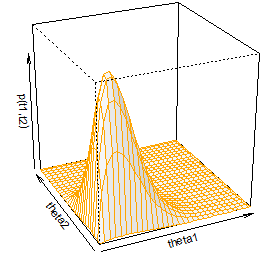Last month I
noted that I was looking into Bayesian data analysis to aid better decision-making with marketing data. Well, it's time to start using some software (
R) and getting to work.
Links to articles on the advantage of Bayesian data analysis over traditional null-hypothesis significance testing (NHST) were provided in that
first post. More good articles can be found on John K. Kruschke's
blog.
In a nutshell, on the plus side with Bayesian analysis you can generate richer information about your parameters. And you don't have the problems of the investigator's intent and the hidden priors of NHST.
The one hitch to Bayesian analysis is that you may have to compute a difficult integral. There are a few techniques to make it doable. First, make the math easier--use conjugate priors and known distributions. Second, numerically approximate the integral; you'll need this especially if your priors can't be adequately expressed with a convenient distribution. This grid approximation won't work, though, if your parameter space gets too large. Then you are on to Markov chain Monte Carlo (MCMC) methods that extend to large parameter spaces.
Over several posts, we'll look at all 3 techniques, even though we can often get away with conjugate priors and convenient math.
For more detail, we're inspired by and playing along with Chapter 8 of
Doing Bayesian Data Analysis by John K. Kruschke. We'll just be using a marketing case instead of the ubiquitous coin flips. (The base R
scripts used for the below come from the book.)
A lot of digital marketing cases involve two binomial proportions--open rates, click rates, conversion rates. Luckily, these cases can be easy to solve via exact formal analysis. Because the Bernoulli likelihood function has a ready conjugate function for our prior--the beta distribution.
When we're doing an A/B test of two treatments, we're trying to make inferences about two independent proportions. We are talking about the space of the two combined parameters--every combination of Click-through rate A (θ
A) and Click-through rate B (θ
B).
So what are we testing, anyway? Well, earlier this year some of us wanted to test a marketer's practice of sending out self-promotional, announcement emails. Buried in these announcement emails were offers for a white paper--an actually valuable offer. In other words, in order to promote a useful white paper, the marketer is sending a "Come See How Wonderful We Are at XYZ Expo" email. (This can be considered a classic case of
going through the marketing motions.) Our hypothesis was that an email directly promoting the white paper would convert better.
So let's get to it.
We need to determine our priors, calculate the likelihood from the data, use Bayes formula to derive the posterior distribution of our parameters (the click-through rates) and then we can compare the underlying rates from A and B. We can do this with an exact analysis using beta distribution priors and Bernoulli likelihoods.
Priors and Likelihoods and Posteriors, Oh My
We're examining a parameter space over θ
A and θ
B. That is the probability p(θ
A, θ
B) over all combinations of θ
A and ϑ
B. In our case, since our channels are independent, p(θ
A, θ
B) = p(θ
A) * p(θ
B). Similarly, our likelihood is a product of two Bernoulli functions. We combine these priors and likelihood functions and, through the magic of beta distros being conjugate to Bernoulli likelihoods, badda bing, badda boom, our posterior is a product of independent beta distributions too.
We have our recipe. Just add some constants, some data, and stir.
Priors
Our historical data shows around a 20% conversion rate for offer emails to this target, so we'll use that in choosing both priors, setting them the same. A beta distribution with a = 2 and b = 8 works nicely.
The prior for B is the same.
A perspective plot over both parameters looks as follows.
Likelihood
Our likelihood functions are:
θ
AzA * (1 - θ
A)
(NA - zA)
and
θ
BzB * (1 - θ
B)
(NB - zB)
where the z's and N's are the number of hits and sample size, respectively, of each channel, A and B. Here is where our sample data entered the mix.
In our test, A is the group that received the self-promotional email. B is the offer email. Our actual data is:
z
A = 85 ; N
A = 637
z
B = 219 ; N
B = 722
Posterior
Through our "badda-bing" math, we have the product of independent beta distributions as our posterior:
beta(θ
A | z
A + a, N
A - z
A + b), and
beta(θ
B | z
B + a, N
B - z
B + b).
Now we can examine the posterior distribution by evaluating it across the θ
A, θ
B space. Here is the contour plot.
What have we learned?
Looking at this plot we can see that θB is very likely greater than θA.
How much greater?
We can sample from the two independent beta distributions of the posterior and compare them. Here we can see the mean of the difference and the 95% HDI (Highest Density Interval) of the difference. The mean and HDI are above zero, leading us to believe that the difference in B over A is real.
That is, the offer email performs better than the self-promotional one.
Much better.
Conclusion: make your content and your emails for your reader, not about yourself.
 There is a certain rationale behind that. For starters, there's really no such thing as 100% retention. (If nothing else, all of today's customers will be dead within 100 years!) So, without a rate of acquisition that beats the rate of attrition, your customer base will shrink to nothing at some point in time.
There is a certain rationale behind that. For starters, there's really no such thing as 100% retention. (If nothing else, all of today's customers will be dead within 100 years!) So, without a rate of acquisition that beats the rate of attrition, your customer base will shrink to nothing at some point in time. One company is highly focused on the discipline of retention marketing. Retention Science are applying the modern techniques of data science to the task of retention. This is important because, while the tools and techniques are similar at a high level, the levers behind optimizing retention are different than those of acquisition. For marketers, and for the tools they use, a focus on the science, strategies, and tactics of retention makes a difference.
One company is highly focused on the discipline of retention marketing. Retention Science are applying the modern techniques of data science to the task of retention. This is important because, while the tools and techniques are similar at a high level, the levers behind optimizing retention are different than those of acquisition. For marketers, and for the tools they use, a focus on the science, strategies, and tactics of retention makes a difference.






